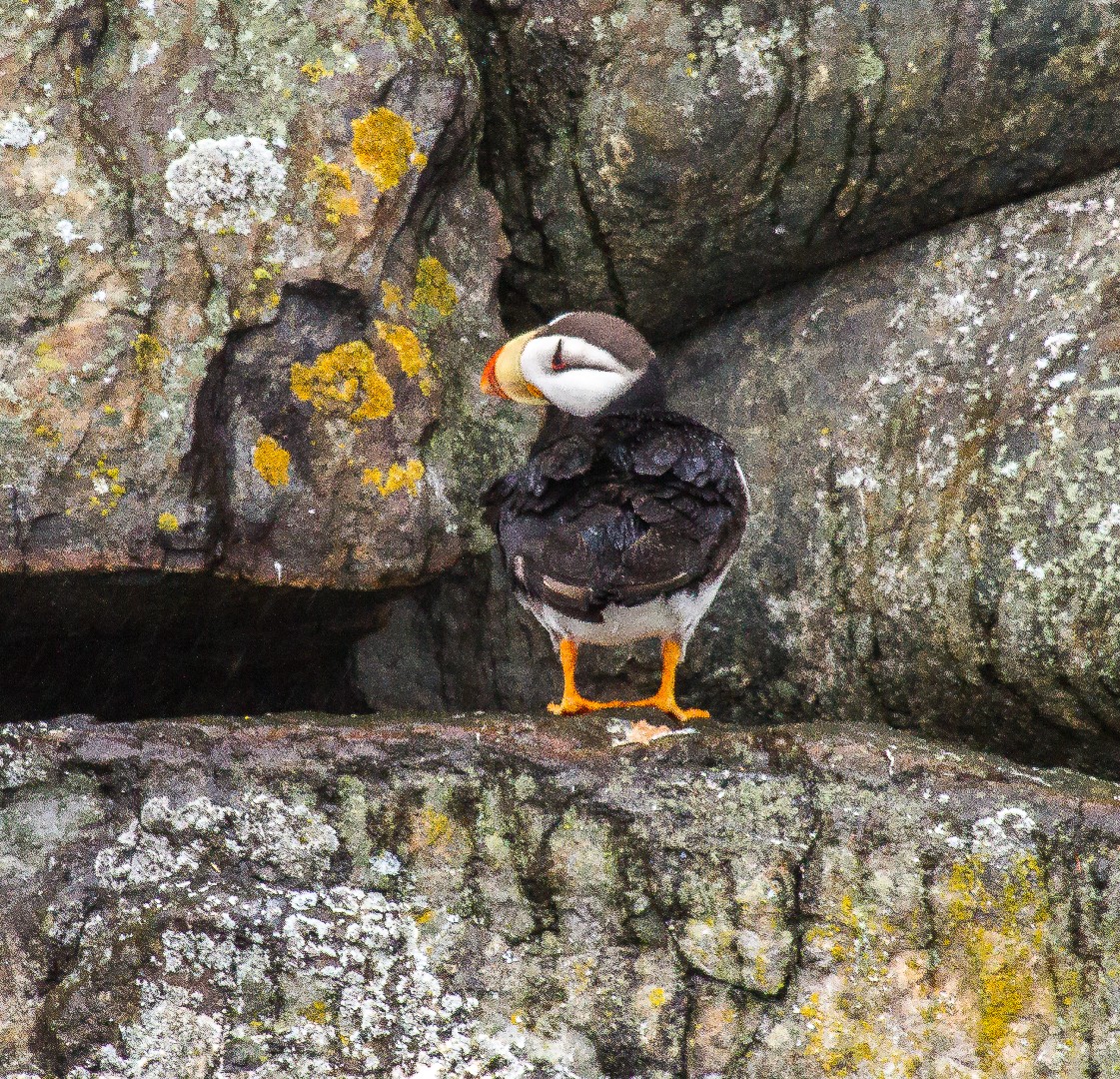Horned Puffin
A species of Puffins Scientific name : Fratercula corniculata Genus : Puffins
Horned Puffin, A species of Puffins
Botanical name: Fratercula corniculata
Genus: Puffins
Content
Description General Info
 Photo By Bo Mertz , used under CC-BY-SA-2.0 /Cropped and compressed from original
Photo By Bo Mertz , used under CC-BY-SA-2.0 /Cropped and compressed from original Description
The height of the adult puffin is approximately 20 cm (8 in), the weight is approximately 500 g (18 oz), and the wingspan is approximately 58 cm (23 in). Horned puffins are monomorphic (the male and female exhibit the same plumage coloration). Sexually mature birds have a small fleshy black "horn" extending upwards from the eye, from which the animal derives its common name — the horned puffin. A dark eyestripe extends backwards from the eye towards the occiput. The cheeks are white, with a yellow wattle at the base of the bill. The legs and feet are orange. The horned puffin's bill, which is larger than those of other puffin species, is red at the tip and yellow at the base. In summer (breeding) plumage, the bill's outer layer – the rhamphotheca – grows in size and turns bright yellow with a dark orange tip. The size and color of the rhamphotheca helps to attract a mate. The brilliant outer layers of the rhamphotheca are shed in late summer, as the face reverts to a gray and black color, and the legs and feet fade to a pale fleshy color. This phase is referred to as eclipse plumage. The puffin's bill has fluorescent properties that are also used to attract a partner. Puffins can see ultraviolet rays, allowing them to spot luminescence on the bills of other puffins during the courtship display. The horned puffin chick has smoky-gray cheeks and a fine, black triangular-shaped beak. The feet are pinkish or greyish. The juvenile's height is less than that of the adult at the time of leaving the nest. Young puffins lose their greyish facial spots during their first springtime. The beak gains its developed form at the age of one year and continues to grow over the years, reaching the brightest coloration at five years, the point of sexual maturity. The puffin reaches its adult size and weight at this period. 
Size
38 cm (15 in)
Life Expectancy
20 years
Nest Placement
Cliff
Feeding Habits
Horned Puffin's diet consists mainly of fish and various invertebrates. During breeding, horned Puffin dives, sometimes over 100 feet, to catch small fish, and can carry multiple fish in its bill for chicks. Post-breeding, horned Puffin consumes fish, squid, octopus, krill, and bristleworms, indicating partial nocturnal foraging for bioluminescent prey like lanternfish.
Habitat
Horned Puffin inhabit marine environments, typically found along sea coasts with rock cliffs and offshore islands. Their breeding colonies favor rocky ledges, deep sea cliffs, boulder-strewn areas, and talus slopes. They prefer nesting above the sea, using natural crevices over excavating burrows. Horned Puffin remain within proximity to their nesting sites while foraging, but can travel over 60 miles to feed in the Gulf of Alaska and Bering Sea. After breeding, they disperse into the open North Pacific Ocean over deep waters, where they spend the winter before juveniles return to breed after two years at sea.
Nest Behavior
Horned Puffin engage in nesting activities that include lining their chosen nest site with soft materials. Egg-laying patterns are not specified, but parental care involves both parents tending to the egg and later the chick, with one staying at the nest while the other forages at sea.
Nest Characteristics
Horned Puffin's nests are typically found on cliffs or slopes of rocky islands, often in crevices or earthen burrows. The nests are lined with materials such as grass, algae, twigs, and feathers. Some nests may have a cup shape, while others hardly show any nest structure.
Dite type
Piscivorous
General Info
Feeding Habits
Bird food type
Behavior
Horned Puffin exhibit elaborate courtship behaviors involving synchronized swimming, prominent bill-raising, head jerking, and distinctive 'billing' where they rub bills together, producing a popping sound. This display continues throughout the breeding season, acting as a bonding ritual and potential signal to others. Daily, horned Puffin interact with their environment by collecting nest material and defending their nesting sites with a show of open bills and wing flapping. Their interaction within their habitat is characterized by such unique displays and territorial defense behavior, reflecting a complex social structure and communication system.
Distribution Area
The horned puffin is relatively common across its range. It is present throughout the northern Pacific Ocean, including the Shumagin Islands of the Bering Sea, the Siberian coast, Kamchatka, Sakhalin, and the Kuril Islands. In North America, it is found on the western coasts of Alaska and British Columbia, Haida Gwaii and the Aleutian Islands. Horned Puffin are also found in the vicinity of the Chukchi Sea and especially on Wrangel Island. More rarely, the species travels as far south as Japan and the coasts of Oregon and California. It is not a migratory bird, although it winters far out to sea. Horned puffins live among steep rocky slopes and cliffs. Unlike other puffins, they dig little or no burrows, preferring rock crevices or shelters under piles of rock for home and shelter. 
Species Status
Not globally threatened.